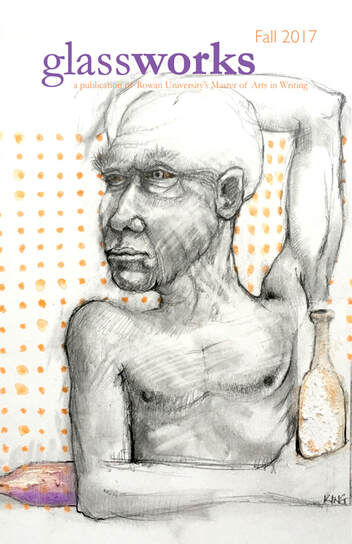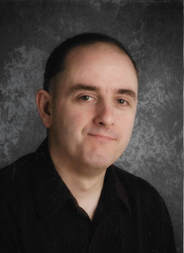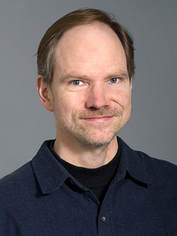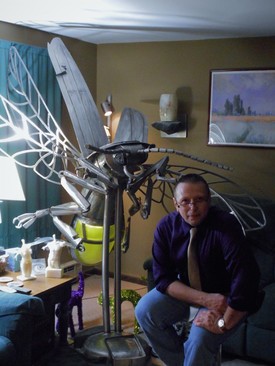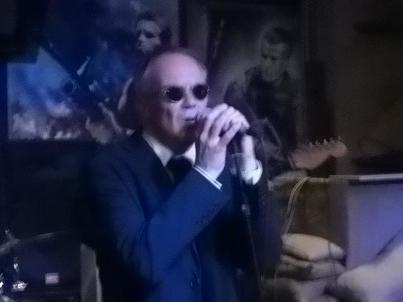|
lookingglass
Through the "Looking Glass," readers are invited to dig deeper into our issues as contributors share reflections on their work. Specifically, "Looking Glass" provides a sort of parlor where authors and artists reveal the genesis of their pieces, as well as provide meta-discursive insight into their textual and visual creative works. Issue 15 Reflections
Read on for reflections by select authors and artists
on the genesis and craft of their pieces in Glassworks and then read the full issue online! |
John Timothy Robinson
"The Farmhouse"
|
I have been interested in prose poetry for many years, though I never became aware of much research until I read Robert Bly’s “The Prose Poem as an Evolving Form” from his Selected Poems as well as Marjorie Perloff’s thoughts on the same issue in contemporary, American poetry. Some scholars deride what they term ‘the prosing of poetry’ or see the Language poetries as incomprehensible. Perhaps complaints of the latter merit valid claims, depending on which poet or what work were under discussion. “The Farmhouse” is not a language poem. In Bly’s typology, this poem falls under the description of a “thing poem,” or what some would call an object poem. This type of poem also has two central tendencies of focus; narrative or description. My poem is about an old farmhouse that has been in our immediate family since 1948. This was my namesake grandpa’s house, my great uncle’s house, my father’s house and since 2001, my house. It has always been our house because our part of the family has always been there, cared for the property, paid the taxes. My law suit against the other part of the family now defends it and sets a political contrast.
|
“The Farmhouse” is about living in that house for many years, or at least what an average day would be like in the colder months. Everything in the poem is a fact of my existence there. My poetic process isn’t always based on paradigms. The work can begin anywhere; idea, object, a line or maybe a rhythm. What I like about what I would call the universal nature of poetic process is that it is radically varied in the way it manipulates and transforms the substance of the material utilized by the poet. There may exist what some call dominant modes of arbitrary and intuitive thought—Jung’s opposing poles of literary types. However, even arbitrary works can illustrate intuitive aspects. And even the most intentionally intuitive work can lack adequate substance to carry it through to a cohesive closure. I suppose “The Farmhouse” is mostly description; structural flaws, effects, methods of escape. Thoreau is still an inspiration in many ways, though I believe he had it better to a certain degree. My toilet truthfully was a five-gallon bucket. A bird would often fly in of the morning, though usually the same one, the only one who knew that tiny, circuitous route to get in.
Susanna Lang
"Bridgetender"
|
I worked on “Bridgetender” during April and May 2016, and when I received Glassworks’ invitation to write about my process in creating this poem, I couldn’t remember at first where the poem came from or what it had been like to write the poem. I was going to take a pass on this opportunity, but I found that I wanted to remember so I started searching my files. I found my first handwritten draft from April 17, some stanzas more scribble than draft. There’s another draft on my hard drive, from three weeks later when I sent it to friends for comment. They were generally positive, suggesting line edits rather than fundamental rethinking, and one asked if I was working on a book focused on the River Styx. His question points to the real origin of the poem, though I also finally remembered what got me going—a StoryCorps piece aired on National Public Radio in which a bridgetender talked about why she loved her job. Many of the details in the poem came from that broadcast; you can find a summary on the NPR website if you search for “bridgetender.” But her story caught my attention because it fit into a constellation of images and metaphors that I had been working on for years, as I watched my father on his long journey toward death, and lost friends to cancers that took them more quickly. My other commenter said that the bridgetender seemed like a minor god receiving instructions from an even more powerful deity who is the speaker in the poem. For me, the bridgetender became a figure like Charon, the ferryman who accompanies souls across the River Styx.
|
Charles Wright said in a workshop I attended that we all have nine images that we return to again and again. I don’t know where he got the number nine, but I think writers are easily haunted by images, or by words. The word “bridgetender” is evocative to me, all by itself. Rivers call to me. Although this poem isn’t included, my most recent book, which was released by Terrapin Books in June 2017, is Travel Notes from the River Styx. (Did you know there is a physical River Styx in Kentucky?) I don’t go looking for poem ideas focused on rivers, and I wasn’t listening to NPR to find a starting point for new writing, but that’s the way my writing mind works. I am grateful to these two friends, Pat Daneman and J. Stephen Rhodes, and to the editors of Glassworks who suggested further edits, for helping me to fine-tune that initial vision so that it sings the way I wanted it to do.
Rod Zink
"The March Of The Leaf-Cutters"
|
If stories were dreams—and dreams, indeed, taken as seriously as any other reality—then “The March of the Leaf-Cutters” could possibly add fuel to the debate over whether cats, big or small, actually do have nine lives. I say this, because as with the fabled multiple lifecycles of our independent feline friends, the origins for my story found root sometime in a past considerably distant to me now, comfortably over twenty years, or so—the blurred line between fact and imagination less distinct with every passing minute.
I believe it began as a conversation I had with a neighbor that persistently surfaced in my mind, like a discarded hollow plastic doll might in the ocean, bobbing up from under the swells of water into the light of the sun, if only for brief moments. I drafted the first version of the story as a graduate student a year or two after the supposed event, only to watch my initial attempts to capture whatever it was that wouldn’t stay down to become beached—to dry out, fade, erode, and eventually crumble through my awkward words. The story, as I had written parts of it to include small snippets of things from the conversation that had initially inspired me at first, became lost again to time when it had failed to get published. In hindsight, it was likely due to a combination lack of experience as a writer, skill, and the real killer—an unwillingness to look beyond the surface of a story draft, and to push aside whatever is necessary to unveil the true story, or to create enough space for the true essence of the story to emerge. A hard copy was eventually tucked neatly away in a cardboard box along with a version saved on a floppy disk, until I recently began to write again, and wanted to use the “leaf-cutters” marching sequence for a new story |
Although it didn’t surprise me to discover that the old story, and my younger writing counterpart, weren’t anywhere close to as good as I had thought the duo to be then (oh, vain deluding joys!), and I really wanted to use the leaf-cutters for my new piece, there was something in the old story that the more seasoned writer I am now could clearly see that I couldn’t before. There it was, so exposed that I blushed at first sight, and had to look away for a moment. Upon second glance, however, the story now stared back up at me like Ms. Brill’s ermine toque, perhaps. I could see that it desperately wanted, needed just one more chance to rise from the cardboard box—to escape the endless dark orbits and infinite loops within the floppy. As the writer I am now, I could hear the story plead its case to reach up, be clothed with new words and scenes, maybe even with new or very different characters, and to speak through whatever new or revised dialogue, actions or situations were necessary to reveal itself, to break the surface and stretch out toward the brief glimmer of light.
Call me soft, but I felt I owed 3-A, Thursday, and the pig-tailed girl at least one more chance.
Call me soft, but I felt I owed 3-A, Thursday, and the pig-tailed girl at least one more chance.
Cordelia M. Hanemann
"Still Life"
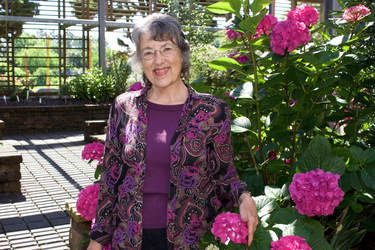
Each poem seems to have a whole life of its own from inception to completion, and, as poets know, we use whatever means we can to get at the heart of what we want to/ must say. For "Still Life" I began with a photograph in the family album which I was perusing at a fraught time in my life. The picture, which should have been full of hope and the future, seemed a reproach to me, like a 'failed' still life. The notion of "still life" seemed to characterize the photo--it resonated with the failed marriage, with the fact that the boy-fruit of that marriage was alienated from me, the failure of a dream. And I've always both hated and been fascinated by those rather macabre 17th century still-lifes with the dead goose. I somehow related my own feelings to the moribund goose. These ideas came together as I tried to interweave the visual with the emotional in writing about a personal experience charged with emotions I had difficulty comprehending and dealing with. The word contumely, I confess, came unbidden from my muse--and it worked. The photo itself is a bit enigmatic--and though I don't own the boy-man--who is happily speaking to me again--or the chair, and my ex-husband is sadly gone, I do still own that still life and this poem, both of which cause me sadness and bring me comfort.
Peter Newall
"The Sleepwalkers"
|
When I write a story, I actually believe I am living in the time and place I am writing about. Indeed, that’s precisely what makes me want to write, to add on another life, or at least another dimension, to my own life. Through the looking-glass, if you like. As a consequence, I usually begin with a specific idea of a place and time, then put people into it and see what they do within the constraints of that situation and their own natures. Most of my stories are set in the Central and Eastern Europe of the last sixty or seventy years, so my characters’ ability to act is often both directed and limited by forces, political and social, beyond their control. But I’m not writing to make any political point; those social circumstances are simply a part of the reality of a given time and place that I want to call up and exist within, just as much as the buildings, the streets, the names of the towns, the newspapers, the music, the weather. All of that detail has to be there to make the story real.
|
In the case of The Sleepwalkers, I’d just watched again Wajda’s 1960’s film Innocent Sorcerers. There are some great scenes set in a Warsaw jazz club; Polish jazz at that time was sublimely wonderful. Much more than the main characters in the film, I was interested in the young men and women you see fleetingly in the audience. Their lives are the fabric of the life of the city at that time. So I wrote about one of them; the narrator could be any one of the unnamed extras in the club that night. And of course I love Warsaw and its mixture of beauty and gloominess and I painted that as realistically as I could, and drawing on my own experience as a musician playing clubs like that I summoned up the music as best I could, so that just for a little while I might believe I was living in Warsaw at that strange time, both luminous and dark at once.

